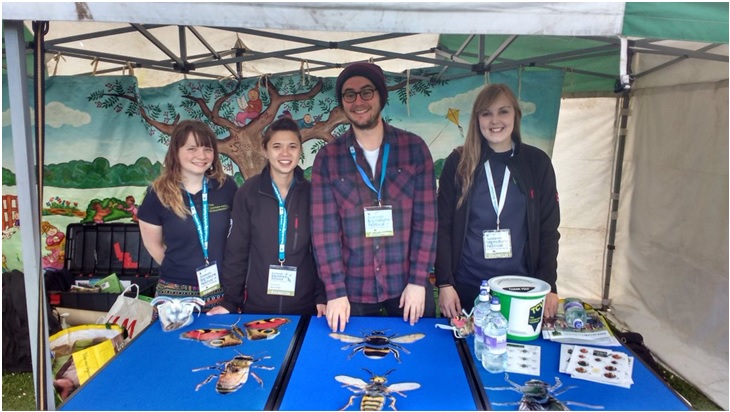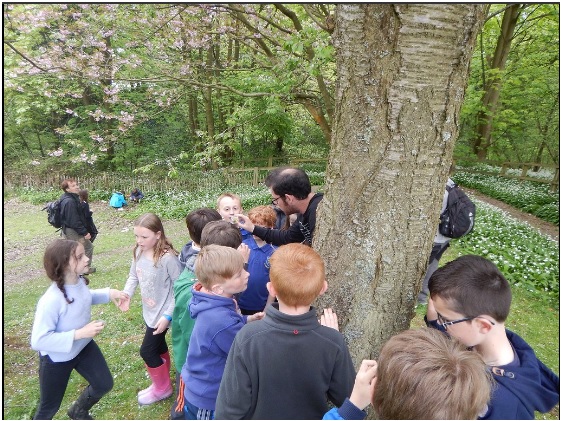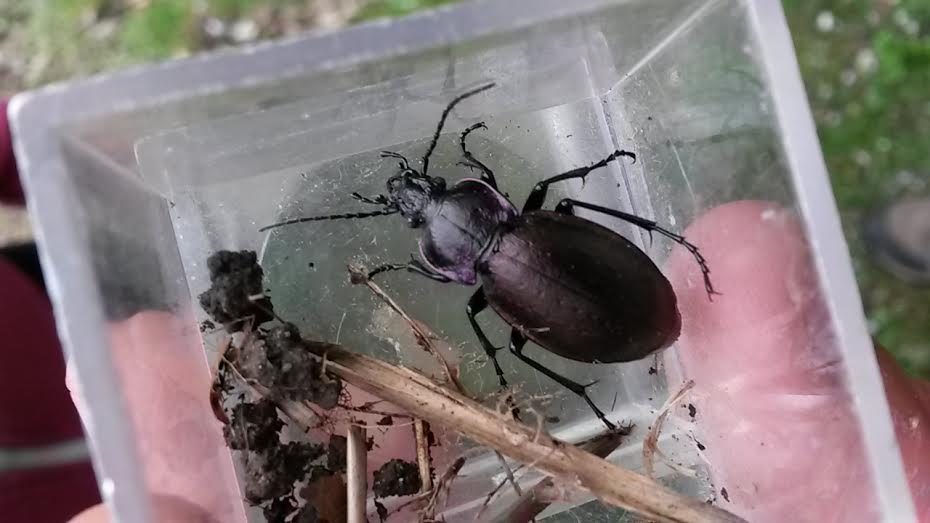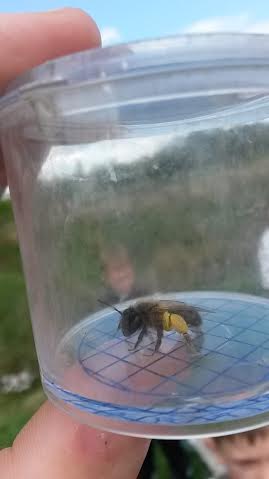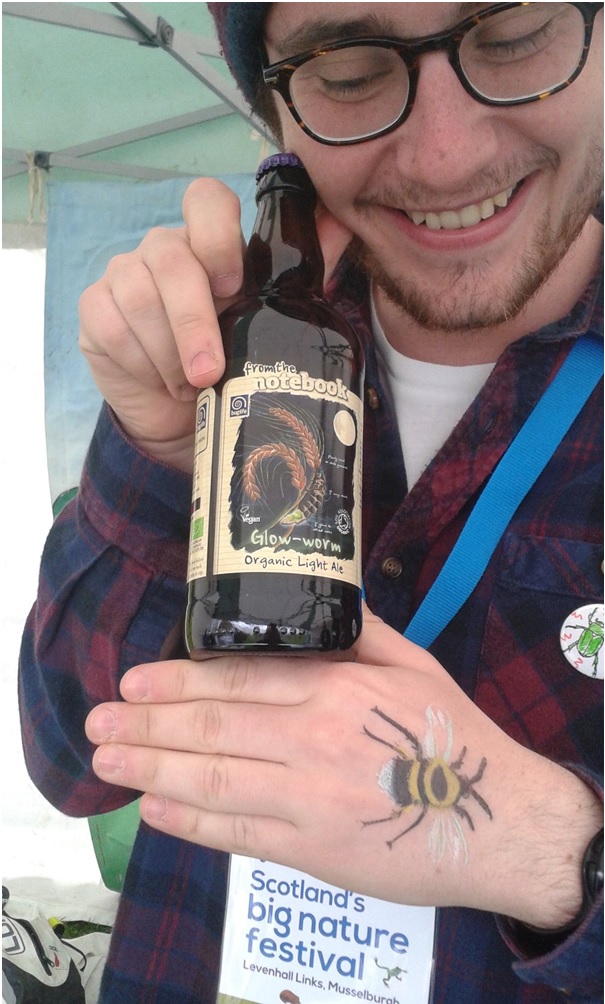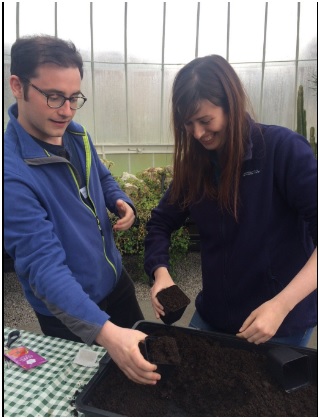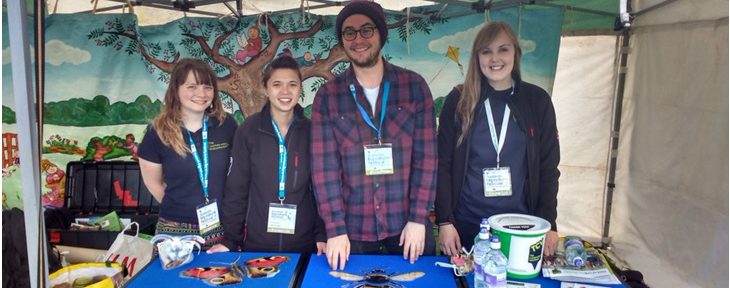
at naturefest
As a massive yellow orb came out from behind the clouds and mysteriously heated everything up this month, my traineeship also heated up (metaphorically speaking, (could you imagine the traineeship actually heated up as you progressed through it though? Think about it)). All the bugs came out briefly did their thing then the orb disappeared and Scotlands four days of summer where over. Pull up a chair to your computer screen, lean in and we will go through it starting………….now.
The third week in April coincided with my colleagues John Muir pollinator way B-lines workshop week (try say the 10 times fast!). This event sought to promote pollinators during the birthday week of one of Scotlands most revered naturalists who established the concept of national parks. He also invented a “getting up out bed machine” (isn’t that what mums are for?). After being involved in a workplace accident that left him temporarily blind, John Muir left his job and went out into nature where he sought to experience everything it could offer. In this spirit we went out along the B-line set up in his name which stretches from Dunbar to Helensburgh spreading his message to the public through pollinator workshops and activities. My first walk was in Helensburgh where we gave a talk concerning the common bumblebees in the area. It was well attended and the public even got a glimpse of a Gwynnes mining bee (Andrena bicolor) nest aggregation which was the first recording of this species in the area.
The next stop was Lennoxtown primary school. It was the sunniest day of the year and absolutely perfect weather for a bug hunt! In the morning we went out with primary 4s. They were really interested in the differences between hoverflys and bees, the smart use of disguise by hoverflies being of particular interest. In the afternoon we went out with the primary 6s and had a look round the same park where we spotted our first butterfly of the season – a small tortoiseshell (Aglais urticae). We were delighted at the end of the day that the kids had so much fun. This proved an informative experience for me.
The week ended with a meadow creation workshop in Linlithgow. The public got a lot from this workshop and where delighted to come on another bugwalk at the end of the session. We found a lot of cool creepy crawlies in the undergrowth surrounding the park. The public were duly dispatched full of bug knowledge, with the added of knowhow of how to upload and update species records.
showing some cool inverts to the pupils of Deanburn primary school
As the month progressed my other colleague got a massive grant for installing meadow sites in north Lanarkshire. So I went out with her and did baseline surveys of these areas to compare the differences before and after installation. It felt nifty putting my Zoology nous to the test (this handsome and a Zoologist you ask?) recording wee beasties in a proper scientific manner. It felt weird not having 20 kids surrounding me asking: “is this a slug?” It was enjoyable and it meant that I got to put many sites to the names which I have frantically gone over in google maps in the search for bug walk sites.
Midway through the month I went down to Buglife towers in Peterborough. This is the main office where the magic happens. I met the whole Buglife gang. Everyone was really lovely and accommodating. It was great to see all these passionate people who work on many different projects; I could not help but feel inspired.
A massive bronze carabid caught by one of the pupils of Deanburn primary school
solitary bee caught by the pupils of Cumbernauld primary school
The staff all gave presentations on their projects. I discussed “North Lanarkshire’s buzzing”, and it went off without a hitch. Everybody seemed interested and I got good feedback on what I could do to improve my walks and talks. I enjoyed my time down in Peterborough and would not hesitate to go back.
I attended an edible garden course at the Glasgow Botanic gardens. After spilling cranberry juice all down my self during the introductions I set out to show how much I knew about the plant world, which turned out to be even more embarrassing. The course was a joy and at the end I felt that I knew a lot more about the logistics of setting up a school garden and how to interpret this for kids. I also got a ton of free seed samples! I now have a pet sunflower ! Further progress on Gerald the sunflowers progress in future blogs……
I also attended a few workshops regarding the Launch of the “urban butterfly” project which is being run by the butterfly conservation trust. This involved a presentation at the botanic gardens and a workshop at Fallin bing which is just outside Stirling. The workshop proved quite useful and we saw our first Peacock butterfly (Aglais io) of the season. We caught a lot of other butterflies but the peacock remains elusive. Until the next time….. (Ok no more ellipsis)
I had an amazing week with St Marys primary school in Cumbernauld Over the space of a week I went out with 120 pupils to Ravenswood bog to survey the minibeasts that reside there. We caught a few bees which are my favourite invertebrate. I can espouse at length about bees but I will save you the time and direct you to your back garden where you should be going bug hunting! You will not regret it.
With the pupils of St Marys I showed them trapping techniques. Their favourite was the “ninja net” technique which involves lots of “ooh, aah, hiya!” sounds with the sweep nets. The magic words work – we caught the first ladybird of the season along with some caterpillars and an annoyed yellow dung fly (Scathophaga stercoraria). The kids were keen on safety and knew precisely how careful they should be when surveying. The responsibility and maturity they showed was heartening and brought a tear to this embittered old cynics eye until he fell face first into a broom shrub (which coincidentally was named “Glasgows favourite plant”, who votes in these things?).
The next school bug walk was at Chapelhall primary school. This was such an awesome day. The sun was shining and all the kids were desperate to get out and see what they could find. They were not disappointed with a few butterflies and a spotting of a common carder bumblebee (Bombus pascuorum). The kids also had great fun setting up bug hotels in the grounds that we chosen. The best bug hotel name was bug-ingham palace. I am not ashamed to admit that I laughed hysterically at this.
10p from each sale of this ale goes to buglife! Found at the big nature festival
The next school on from that was Dykehead primary school in Shotts. This area has such a lovely nature park that I felt it would be remiss of me not to use it. The kids really appreciated the variety of habitats found in this park and they got a lot out of it. Routing around in the undergrowth; searching on flowers and in log piles. We found lots of wacky centipedes and devious hoverflys. The kids were particularly amazed at the fact that the oldest fossil invertebrate found yet was from a millipede which was 400 million years old! Nearly as old as my jokes!
Another endearing experience for me this past month was going to Allanton primary school. The kids were so enthusiastic and were amazed to hear about all the things that live just under their feet. They really enjoyed playing the camouflage game but couldn’t find any of the brown string that I had hidden; it is still hidden to this day. They got to thinking about the morphology of invertebrates such as bees, woodlouse and worms. Why are they built like they are? What are their needs? They did this by drawing their ideal invertebrates for pollinating flowers, digging into wood and pushing through soil. The kids drew these inverts using their chalk and they noticed a recurrence of the same features in each group. This was a useful activity which I hope to use again.
getting soil everywhere at the garden workshop at glasgow botanic gardens
The main event of this month was the big nature fest in Musselburgh. This is a massive event organised by the RSPB which bring together a lot of environmental organisation into a big part where they talk to the public at stalls about conservation. It proved a successful day out from TCV and the public seemed really enthused about our citizen science approach and our badge making machine. It was hectic but the team pulled together and made it an informative and engaging experience.
These last six weeks have been so rewarding. It feels like I have been in a whirl of constant motion, moving from bug walks to events. The best part is that it’s only been four months; I still have another eight months of leading the public on a bug walk adventure. Next stop: Bug-ingham palace! Or Cumbernauld, whatever is marked in my diary.
